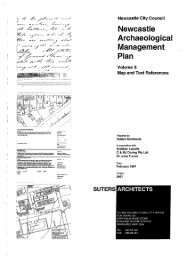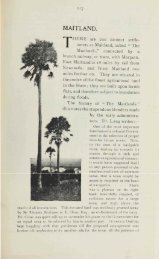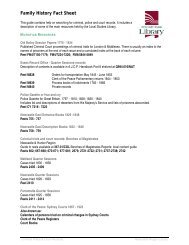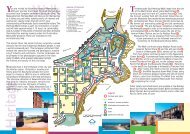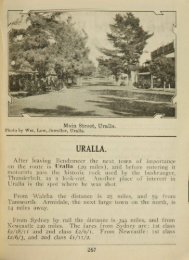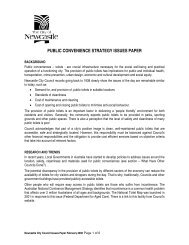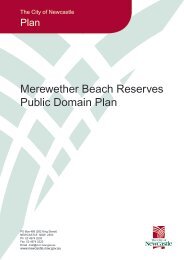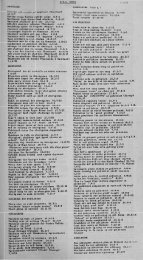Curious Colony: - Newcastle City Council
Curious Colony: - Newcastle City Council
Curious Colony: - Newcastle City Council
Create successful ePaper yourself
Turn your PDF publications into a flip-book with our unique Google optimized e-Paper software.
<strong>Curious</strong> <strong>Colony</strong>:<br />
a twenty first century Wunderkammer<br />
DAVID HANSEN<br />
right At the stArt of <strong>Curious</strong> <strong>Colony</strong> is an 1814 portrait by<br />
Richard Read Sr of the young immigrant John Buckland.<br />
The watercolour has at some point in its history been<br />
cleaned using chloramine-T, a process which leaves a<br />
crystalline residue, and the picture looks as if it has been<br />
dusted with glitter powder. It is an appropriate beginning,<br />
for this is an exhibition which sparkles, both literally and<br />
figuratively. Curator Lisa Slade has assembled a collection of<br />
some three dozen early colonial paintings, drawings, prints<br />
and pieces of furniture, together with works by eleven<br />
contemporary artists – Brook Andrew, Fiona Hall, Narelle<br />
Jubelin, Fiona MacDonald, Danie Mellor, Kate Rohde, Joan<br />
Ross, Sarah Smuts-Kennedy, Robyn Stacey, Imants Tillers<br />
and Louise Weaver – selected to reflect or comment upon,<br />
illuminate or extend the imagery and meanings of the<br />
historical material.<br />
Centrepiece and summary of the show is an<br />
extraordinary postcolonial artefact, the <strong>Newcastle</strong> chest, a<br />
deliberate re-creation or re-imagining of the famous<br />
Macquarie collector’s chest. 1 The original, purchased by the<br />
Mitchell Library in 2004, houses the Australian natural<br />
history specimens collected by Governor and Mrs Macquarie<br />
w w w . a r t m o n t h l y . o r g . a u A r t M o n t h l y A u s t r a l i a<br />
– birds, insects, fish, shells, seaweeds – densely packed into<br />
the trays and drawers of a cedar chest by convict<br />
cabinetmaker William Temple. Regrettably, the box is fragile,<br />
and could not travel to the exhibition, but its absence was<br />
certainly compensated for by this miniature ‘21 st century<br />
wunderkammer,’ commissioned especially for the <strong>Newcastle</strong><br />
Region Art Gallery and paid for entirely by local donations.<br />
Canberra craftsman Scott Mitchell built a new chassis<br />
matching Temple’s dimensions and basic structure, and five<br />
artists were commissioned to produce the contents: Lionel<br />
Bawden, Maria Fernanda Cardoso, Esme Timbery, Louise<br />
Weaver (again) and Philip Wolfhagen.<br />
Exhibitions of such imagination, ambition and<br />
intelligence are rare enough in the Australian art museum<br />
firmament; that this project should also be closely,<br />
strategically linked to collection development is further<br />
testimony to the institution’s curatorial nous.<br />
Why am I so enthusiastic? Let me begin with the<br />
hang, an aspect of exhibition making that usually receives<br />
scant critical attention. Not the design – colour ways and<br />
typography, display furniture and lighting – but the layout,<br />
the adjacencies of works, the spaces between them, the<br />
#233 September 2010 5
subtle filaments of subject, material, scale, form and colour<br />
that create a show’s experiential dynamic, its narrative. The<br />
perennial challenge of the hang is particularly acute with an<br />
exhibition such as this, with its 200-year time span and its<br />
great stylistic variety, but it has been managed with both<br />
flair and subtlety.<br />
For example, Smuts-Kennedy’s shell-fungusstalagmite<br />
columns, topped with varnished and gilded lumps<br />
of coal, are arranged on a shelf beneath John Lewin’s Nobby<br />
Island from Coal River. While the objects’ collective title,<br />
Pyramid Scheme, clearly alludes to contemporary capitalism,<br />
calling to mind the long lines of coal-loading conveyors just<br />
down the road at Port Waratah, the works are equally<br />
historical in reference, reminding us as much of the first<br />
discovery of coal in the region, of the fact that the Nobbys was<br />
originally named Coal Island. This antiquarian resonance<br />
continues on the next, perpendicular wall, where some of<br />
Smuts-Kennedy’s columns are displayed inside the elegantlyproportioned<br />
King secretaire, oldest known surviving example<br />
of Australian colonial furniture. Behind its doors, with their<br />
vertical-elliptical windows, the white objects look like rococo<br />
porcelain, regency lace or melting candlesticks, while the<br />
terracotta ones pick up the rich red-browns of the cabinet’s<br />
‘beefwood’ (she-oak) veneers. From here the eye slips to the<br />
next visible wall, the next point of an exhibition visitor’s<br />
circumambulation. There we see Mellor’s Dreaming beyond<br />
paradise (let sleeping giants lie), a drawing featuring the<br />
artist’s trademark postcolonial dialectic of indigenous<br />
kangaroo and imperial willow pattern china. But in addition<br />
to its image politics, it is significant that this work is<br />
contained within a horizontal ellipse, thus providing a<br />
subconscious formal continuity from the King cabinet.<br />
Now a choice is offered. The viewer can continue on<br />
her clockwise way around the exhibition’s perimeter,<br />
following authorship and curvature and botany in the<br />
direction of Mellor’s mezzotint Cyathea cooperi and thence to<br />
Hall’s Fronding vase and a suite of fern-mounted emu eggs.<br />
Alternatively, she can diverge to the animal right, past<br />
Walter Preston’s 1820 engraving of cutely incorrect,<br />
heraldically-opposed kangaroos, to The Island V, Andrew’s<br />
dramatic appropriation 2 showing a big old ‘boomer’<br />
defending himself against a pack of hunting dogs.<br />
Which brings me back to the sparkle I mentioned at<br />
the start of this review. Andrew’s work is an all-over freshblood<br />
red, but it is also printed on silver foil, and the<br />
reflective nature of the material, together with the crushing<br />
and grazing of the printing process, gives the surface a shine<br />
that from certain angles and in certain lights quite occludes<br />
the image, a flickering ruby chiaroscuro which matches that<br />
of the firelight in James Wallis and Joseph Lycett’s<br />
corroboree pictures just around the corner. There is more<br />
silver in Hall’s Paradisus Terrestris sardine cans, in the 19 th<br />
century mounts of the emu eggs, in the ‘holey dollars’ of<br />
Jubelin’s Origins and originality. There is gold, too: a golden<br />
yellow in the plumage of the regent bowerbird, both as<br />
drawn by convict artist Richard Browne and as<br />
taxidermically preserved under a Victorian glass dome; a<br />
yellow repeated in Weaver’s <strong>Newcastle</strong> chest wattle wreath<br />
and in her Golden snipe (complete with gold-leafed legs and<br />
beak); in the sulphur cockatoo crest, the gold-painted coffin<br />
and branches and the brass king plates of Mellor’s<br />
installation The native’s chest, as well as in Smuts-<br />
Kennedy’s gilded coal. The allure of precious metals, of trade<br />
beads and trinkets, continues in the colour and shine of<br />
Rohde’s goofy bombonniere, in the nacreous glitter of<br />
Timbery’s shellwork, and in the tiara worn by Mellor’s<br />
princess parrot.<br />
Of course, one could as easily describe other common<br />
devices. Perhaps unsurprisingly, the grid is a recurrent<br />
trope. Emblem of the imperial controlling gaze, of mapping<br />
and surveying, of classification and compartmentalisation<br />
(to divide is to conquer), in the colonial context we see it in<br />
6 #233 September 2010 w w w . a r t m o n t h l y . o r g . a u A r t M o n t h l y A u s t r a l i a
the geometric layout of the drawers of<br />
the collector’s chest, in the neat<br />
rectilinearity of the early settlement of<br />
<strong>Newcastle</strong>, even in the Macquarie<br />
tartan. 200 years on, it echoes in the<br />
rectangles of Tillers’s canvas boards<br />
and Andrew’s foil sheets, in<br />
MacDonald’s woven photographs, in<br />
the hexagons of Bawden’s pencil<br />
honeycombs and in the fine nets of<br />
Jubelin’s needlepoint and Weaver’s<br />
crochet. Seashells, a key feature of the<br />
Macquarie chest, are another favourite,<br />
appearing not only in the painted<br />
decoration of the 1818 Riley cabinet<br />
(here publicly exhibited for the first<br />
time), but also manifest in various<br />
ways in Bawden, Mellor, Rohde, Smuts-<br />
Kennedy and Timbery.<br />
Indeed, what is so delightful<br />
about this exhibition is its<br />
multivalency, the way it establishes a<br />
rich, complementary context for each<br />
individual artist and/or work while<br />
allowing each its own idiosyncracy. It is<br />
committed without being<br />
programmatic, informed without being<br />
doctrinaire. Although very much a<br />
<strong>Newcastle</strong> affair, it welcomes and<br />
promotes reference to other sites and<br />
histories: Stacey’s photographs are<br />
about the Macleays of Elizabeth Bay<br />
w w w . a r t m o n t h l y . o r g . a u A r t M o n t h l y A u s t r a l i a<br />
P5: The <strong>Newcastle</strong> Chest 2010: Cabinetmaker: Scott<br />
Mitchell; Artists: Lionel Bawden, Maria Fernanda<br />
Cardoso, Esme Timbery, Louise Weaver and Philip<br />
Wolfhagen. Commissioned by <strong>Newcastle</strong> Region<br />
Art Gallery. Purchased with the assistance of<br />
James and Judy Hart, Robert and Lindy Henderson,<br />
Valerie Ryan, <strong>Newcastle</strong> Art Gallery Society and<br />
<strong>Newcastle</strong> Region Art Gallery Foundation 2010.<br />
Collection: <strong>Newcastle</strong> Region Art Gallery.<br />
P6: 1/ John Lewin, Nobby Island from Coal<br />
River, 1807, watercolour on paper, 33.2<br />
x 43.7 cm. Purchased 1964. Collection:<br />
<strong>Newcastle</strong> Region Art Gallery.<br />
2/ Sarah Smuts-Kennedy, Pyramid scheme, 2009,<br />
Jovi Clay, resin, coal sourced from <strong>Newcastle</strong>,<br />
imitation gold leaf, dimensions variable. Purchased<br />
2009 and gifted by the artist. Collection: <strong>Newcastle</strong><br />
Region Art Gallery. Image courtesy the artist<br />
and Sophie Gannon Gallery, Melbourne.<br />
House, Sydney; Wolfhagen’s painted parrot is not local, but a Tasmanian species;<br />
while Cardoso’s camouflage insects comment on the desire of all immigrants to fit<br />
in, to not stand out. The exhibition’s dynamic cross-referencing of the national<br />
and the local, the historical and the contemporary, the theoretical and the sensual<br />
is perhaps best exemplified in Ross’s wonderfully nutty video, When I grow up I<br />
want to be a forger, produced (like Mellor’s The native’s chest installation)<br />
especially for the show. In this work, Joseph Lycett’s print The sugar loaf<br />
mountain, near <strong>Newcastle</strong> has been digitally animated. We see the trees waving in<br />
the wind, the clouds reshaping into those of Lycett’s oil painting Inner view of<br />
<strong>Newcastle</strong>, and the two hunters running across the grass, schooners (and the<br />
Nobbys, too!) drift across the water, while one vessel runs aground in a 19 th<br />
century prequel of the 2007 Pasha Bulker stranding. A hunting dog bounds into a<br />
tree, flushing out a screeching, squawking flock of psychedelic spirograph circles,<br />
while a moth from the Macquarie chest lays a ring of eggs. Furthermore, all the<br />
staffage (settlers, Aborigines, even a galah) wear hi-vis clothing – a ‘visual<br />
imperialism’ with which the artist is currently obsessed – their orange vests with<br />
white flashes making a neat analogy with the redcoat uniforms and cross-belts of<br />
Laughing Waters Artist-in-Residence<br />
Applications now open for 2011<br />
Nillumbik Shire <strong>Council</strong>, in partnership with Parks Victoria,<br />
invite contemporary artists working in any medium to<br />
apply for a live-in residency of up to four months in one<br />
of two properties located in protected Eltham bushland,<br />
approximately 30 kilometres north-east of Melbourne.<br />
Artists are required to devise and deliver small community<br />
projects. Joint and group applications will be considered.<br />
P7: 1/ Louise Weaver, Golden snipe, 2010, handcrocheted<br />
lamb’s wool over taxidermied Australian<br />
snipe (Gallinagohardwickii), Australian red cedar<br />
(Toona ciliata), cotton perlé crochet thread, cotton<br />
embroidery thread, felt and gold leaf, 26.6 x 22.5<br />
x 16cm. Collection: <strong>Newcastle</strong> Region Art Gallery.<br />
Image courtesy the artist and Darren Knight<br />
Gallery, Sydney. Photograph by Mark Ashkanasy.<br />
2/ Kate Rohde, Live forever no. 3, 2010, mixed<br />
media, 105 x 40 x 40cm. Image courtesy the<br />
artist and Karen Woodbury Gallery, Melbourne.<br />
3/ Danie Mellor, The Native’s Chest (detail),<br />
2010, mixed media installation, dimensions<br />
variable. Produced with support from the Australia<br />
<strong>Council</strong> for The Arts. Image courtesy the artist<br />
and Caruana and Reid Fine Art, Sydney.<br />
Applications close:<br />
4pm, Tuesday 26 October 2010<br />
Forms and information:<br />
www.nillumbik.vic.gov.au<br />
artsinfo@nillumbik.vic.gov.au<br />
or (03) 9433 3359<br />
#233 September 2010 7
British colonial soldiery. On the soundtrack, a magpie flying<br />
overhead has the drone of a light plane, while the sailing<br />
ships make the foghorn blasts of modern coal transports. So<br />
right. So wrong.<br />
Okay, there are one or two things in <strong>Curious</strong> <strong>Colony</strong><br />
with which I would take issue. Tillers’s White Aborigines<br />
sounds a discordant, or rather anachronistic, note: it is a<br />
relic of the first, heavily theoretical generation of postcolonial<br />
art practice, in which the act of appropriation constituted a<br />
sufficient aesthetic-political ground for art in and of itself.<br />
Against the ludic, light, bright and nuanced work of the<br />
fourteen other artists, Tillers’s stolid, Teutonic imagery and<br />
palette, his Kieferish grey scale, seem just a bit dull.<br />
On the colonial front, I would like to have seen<br />
something of the work of Edward Close, the military engineer<br />
responsible for building ‘Mrs Macquarie’s Pier’, the breakwater<br />
to the Nobbys. Close’s 3.6-metre panorama of <strong>Newcastle</strong> shows<br />
another aspect of early settler artists’ voracious appetite for<br />
recording the visible facts of their surroundings. Moreover, the<br />
self-deprecating inscription (beneath a vignette of dancing<br />
Aborigines) ‘this corrobery [sic] has no business here as it is<br />
never danced in the daytime’ epitomises the artificiality, the<br />
ironic self-awareness of much amateur drawing in the early<br />
colonial period. Similarly, some of Richard Browne’s Aboriginal<br />
portrait watercolours would have served to give Awabakal<br />
identity an individual face; it is a pity that the gallery was<br />
unable to acquire one of those sold in June from the Owston<br />
Collection. Still on the question of Aboriginal portraits, it<br />
should be pointed out that the two sheets of watercolours from<br />
the <strong>Newcastle</strong> Region Library Collection attributed to Augustus<br />
Earle are in fact later 19 th century copies after Earle, Nicolas-<br />
Martin Petit and others. 3 Finally, I would question (as a<br />
Jeffrey BREN - The Dark Mirror<br />
Sat 14 Aug - Sun 26 Sept<br />
Jerey Bren, The Birds, 1970 (detail), oil on canvas. Collection Art Gallery of Ballarat<br />
Gift of Barbara Seddon under the Cultural Gifts Program, 2002<br />
Art Gallery of Ballarat<br />
40 Lydiard Street North<br />
Ballarat Victoria 3350<br />
Telephone: 03 5320 5858<br />
artgalleryballarat.com.au<br />
number of art historians have since the 1970s) the attribution<br />
of the little still life of flowers and fruit at the start of the show<br />
to the convict artist W.B. Gould. No matter; the life in the<br />
painting glows so brightly, and it makes such a perfect<br />
pendant to Robyn Stacey’s Bombe (Cape bulbs) that it seems<br />
churlish to object to its inclusion.<br />
The greater truth of this exhibition, its bigger picture<br />
is, quite simply, as irrefutable as it is splendid. b<br />
1. Lisa Slade flagged her obsession with this object, and<br />
predicted the commission and exhibition in ‘Art on the rebound’,<br />
Art Monthly Australia, no. 216, December 2008, pp. 11-13. The<br />
chest is described in a recent, splendid monograph by Elizabeth<br />
Ellis: Rare & <strong>Curious</strong>: the secret history of Governor Macquarie’s<br />
collector’s chest, The Miegunyah Press, Melbourne, 2010.<br />
2. The original of the image is an engraving by Gustav Mutzel,<br />
from naturalist William Blandowski’s Australien in 142<br />
Photographischen Abbildungen, 1862, soon to be published for<br />
the first time in an English edition, edited by Harry Allen for the<br />
Aboriginal Studies Press.<br />
3. Apart from the stylistic discrepancies, the inscription ‘Papua<br />
Malay’ on one sheet suggests the drawings date from after the<br />
biogeographical Papua-Malaya distinction (‘the Wallace Line’)<br />
was described by Alfred Russell Wallace, in 1869.<br />
<strong>Curious</strong> <strong>Colony</strong>: a twenty first century Wunderkammer, curated<br />
by Lisa Slade, was exhibited at <strong>Newcastle</strong> Region Art Gallery, 10<br />
July to 29 August 2010.<br />
David Hansen is a Senior Researcher and Art Specialist for<br />
Sotheby's Australia, with over 25 years experience as a gallery<br />
director and curator.<br />
8 #233 September 2010 w w w . a r t m o n t h l y . o r g . a u A r t M o n t h l y A u s t r a l i a




